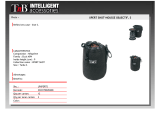
TABLE OF CONTENTS
Power Xpertt 9395 UPS (300 kVA) Installation and Operation Manual S 164201728 Rev 2 www.eaton.com/powerquality
iv
List of Figures
Figure 1‐1. Eaton 9395 UPS (300 kVA) Cabinet 1-2................................................................
Figure 3‐1. UPS Cabinet Dimensions (Front View) 3-3..............................................................
Figure 3‐2. UPS Cabinet Dimensions (Right Side View) 3-3..........................................................
Figure 3‐3. UPS Cabinet Dimensions (Top View) 3-4...............................................................
Figure 3‐4. UPS Cabinet Dimensions (Bottom View) 3-4............................................................
Figure 3‐5. UPS Cabinet Dimensions (Bottom View with Mounting Brackets) 3-4...........................................
Figure 3‐6. UPS Cabinet Center of Gravity 3-5...................................................................
Figure 3‐7. Remote EPO Switch Dimensions 3-5..................................................................
Figure 3‐8. UPS Cabinet as Shipped on Pallet 3-15.................................................................
Figure 4‐1. Removing the Left Side Shipping Bracket 4-3............................................................
Figure 4‐2. Removing the Right Side Shipping Bracket 4-4...........................................................
Figure 4‐3. Conduit and Wire Entry Locations 4-6.................................................................
Figure 4‐4. UPS Power Terminal Locations 4-7...................................................................
Figure 4‐5. UPS Power Terminal Detail AA 4-8...................................................................
Figure 4‐6. UPS Power Terminal Detail BB – Common Battery 4-9.....................................................
Figure 4‐7. UPS Power Terminal Detail BB – Separate Battery 4-10.....................................................
Figure 4‐8. Interface Terminal Locations 4-12....................................................................
Figure 4‐9. Interface Terminal Detail AA 4-14....................................................................
Figure 4‐10. Typical Alarm Relay Connection 4-14.................................................................
Figure 4‐11. Terminal Blocks TB1, TB2, and TB3 Connector Assignments 4-15.............................................
Figure 4‐12. Typical Battery Interface Connection 4-17..............................................................
Figure 4‐13. X-Slot Communication Bays 4-18....................................................................
Figure 4‐14. REPO Switch 4-19...............................................................................
Figure 4‐15. Normally-Open REPO Switch Wiring 4-21..............................................................
Figure 4‐16. Normally‐Closed REPO Switch Wiring 4-22.............................................................
Figure 4‐17. Normally‐Closed and Normally‐Open REPO Switch Wiring 4-22...............................................
Figure 5‐1. Powerware Hot Sync CAN Bridge Card 5-1.............................................................
Figure 5‐2. Powerware Hot Sync CAN Bridge Card Connections 5-3....................................................
Figure 5‐3. Remote Monitor Panel II and Relay Interface Module II Terminal Locations 5-5....................................
Figure 5‐4. Remote Monitor Panel II, Relay Interface Module II, or Supervisory Contact Module II Wiring 5-5......................
Figure 5‐5. J1, J2, J3, and J4 15-Pin D-Sub Connectors 5-7..........................................................
Figure 5‐6. Supervisory Contact Module II Terminal Location 5-8......................................................
Figure 5‐7. Supervisory Contact Module II TB2 5-9................................................................
Figure 5‐8. Remote Monitor Panel II Dimensions 5-10...............................................................
Figure 5‐9. Relay Interface Module II Dimensions 5-11..............................................................
Figure 5‐10. Supervisory Contact Module II Dimensions 5-12.........................................................
Figure 6‐1. Main Elements of the UPS System 6-1................................................................
Figure 6‐2. Path of Current Through the UPS in Normal Mode 6-2.....................................................
Figure 6‐3. Path of Current Through the UPS in Bypass Mode 6-3
......................................................
Figure 6‐4. Path of Current Through the UPS in Battery Mode 6-4.....................................................
Figure 6‐5. UPS System, Output Dual‐Feed 6-6...................................................................
Figure 6‐6. UPS System with Field Installed UPM, Dual‐Feed, Common Battery 6-7.........................................
Figure 6‐7. UPS System with Field Installed UPM, Output Dual‐Feed, Separate Battery 6-8...................................
Figure 6‐8. Simplified Dual-Feed UPS with Maintenance Bypass Panel 6-9...............................................
Figure 7‐1. UPS Controls and Indicators 7-1.....................................................................
Figure 7‐2. UPS Control Panel 7-2............................................................................
Figure 7‐3. Parts of the LCD 7-4.............................................................................





















